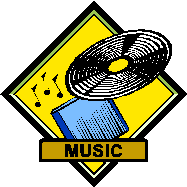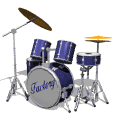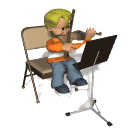 The
Music Curriculum in California
The
Music Curriculum in California The
Music Curriculum in California
The
Music Curriculum in CaliforniaCalifornia Visual and Performing Arts Frameworks and Standards
What should your students know and be able to do in...
Music?
Visual Arts?
Theatre?
Dance?
Visual and Performing Arts Frameworks (2003) - http://www.cde.ca.gov/ci/vp/cf/documents/atocintro.pdf
"A discussion about the arts is a discussion about people. It is about how people communicate their perceptions, responses, and understandings of the world to themselves and to others. The story of the arts began more than 35,000 years ago and has been evolving ever since, exhibiting the ability of humans to intuit, symbolize, think, and express themselves through dance, music, theatre, and the visual arts. Each of the arts contains a distinct body of knowledge and skills that characterize the power of each to expand the perceptual, intellectual, cultural, and spiritual dimensions of human experience.
This capacity of human beings to create and appreciate the arts is just one of many reasons to teach the arts in the schools. Study and practice in the arts refine students’ abilities to perceive aesthetically, to make connections between works of art and the lives people live, and to discuss visual, kinesthetic, and auditory relationships. Students learn to locate works of art in time and place, make reasoned judgments about them, and investigate how artworks create meaning."
 California Visual
and Performing Arts Frameworks
California Visual
and Performing Arts Frameworks
California Department of Education. (2001). Visual and Performing Arts Framework. Sacramento, CA: California Department of Education - http://www.cde.ca.gov/ci/vp/cf/documents/vpaframework.pdf
California Department of Education (2003). Draft of the Visual and Performing Arts Framework - http://www.cde.ca.gov/ci/vp/cf/
California Visual and Performing Arts Standards
California Visual and Performing Arts Standards Complete Online - http://www.cde.ca.gov/be/st/ss/index.asp
Visual Arts - http://www.cde.ca.gov/be/st/ss/vamain.asp
California Visual and Performing Arts Standards (Adobe Acrobat Reader) - http://www.cde.ca.gov/re/pn/fd/documents/visperfmarts-stnd-comp.pdf
Individual PDF Files for Visual and Performing Arts Standards:
English Language Development Standards - http://www.cde.ca.gov/re/pn/fd/documents/englangdev-stnd.pdf
 State
Standards for Music (Visual and Performing Arts)
State
Standards for Music (Visual and Performing Arts)
California Standards - http://www.cde.ca.gov/be/st/ss/index.asp
Visual and Performing Arts (pdf) - http://www.cde.ca.gov/re/pn/fd/documents/visperfmarts-stnd-comp.pdf
California Standards for Music (web) - http://www.cde.ca.gov/be/st/ss/mumain.asp
Prekindergarten Standards - http://www.cde.ca.gov/be/st/ss/muprekindergarten.asp
California Standards for Music (pdf) - http://www.cde.ca.gov/re/pn/fd/documents/music-stnd.pdf
California Visual and Performing Arts Frameworks - http://www.cde.ca.gov/ci/vp/cf/documents/vpaframework.pdf
|
California Pre-kindergarten Standards for Music Prekindergarten Standards - http://www.cde.ca.gov/be/st/ss/muprekindergarten.asp
1.0 ARTISTIC PERCEPTIONProcessing, Analyzing, and Responding to Sensory Information Through the Language and Skills Unique to Music Students read, notate, listen to, analyze, and describe music and other aural information, using the terminology of music.
2.0 CREATIVE EXPRESSIONCreating, Performing, and Participating in Music Students apply vocal and instrumental musical skills in performing a varied repertoire of music. They compose and arrange music and improvise melodies, variations, and accompaniments, using digital/electronic technology when appropriate.
3.0 HISTORICAL AND CULTURAL CONTEXTUnderstanding the Historical Contributions and Cultural Dimensions of Music Students analyze the role of music in past and present cultures throughout the world, noting cultural diversity as it relates to music, musicians, and composers.
4.0 AESTHETIC VALUINGResponding to, Analyzing, and Making Judgments About Works of Music Students critically assess and derive meaning from works of music and the performance of musicians according to the elements of music, aesthetic qualities, and human responses.
5.0 CONNECTIONS, RELATIONSHIPS, APPLICATIONSConnecting and Applying What Is Learned in Music to Learning in Other Art Forms and Subject Areas and to Careers Students apply what they learn in music across subject areas. They develop competencies and creative skills in problem solving, communication, and management of time and resources that contribute to lifelong learning and career skills. They learn about careers in and related to music.
|
National
and State Subject Matter Content Standards
National Standards- http://www.education-world.com/standards/index.shtml
National Standards Table of Contents: http://www.education-world.com/standards/national/toc/index.shtml
State Standards - http://www.education-world.com/standards/state/index.shtml
California
Subject Matter Content Standards
Locate the subject matter content standards for your grade level. Some will be Adobe Reader pdf files and others will be web html files. You will need to include a specific content standard you feel could be met in your multiple intelligences lesson plan.





From the California Standards Introduction - "Dance, music, theatre, and the visual arts have endured in all cultures throughout the ages as a universal basic language. The arts convey knowledge and meaning not learned through the study of other subjects. Study in and through the arts employs a form of thinking and a way of knowing based on human judgment, invention, and imagination. Arts education offers students the opportunity to envision, set goals, determine a method to reach a goal and try it out, identify alternatives, evaluate, revise, solve problems, imagine, work collaboratively, and apply self-discipline. As they study and create in the arts, students use the potential of the human mind to its full and unique capacity. The visual and performing arts are a vital part of a well-rounded educational program for all students.
For each arts discipline the content standards are grouped under five visual and performing arts strands: artistic perception; creative expression; historical and cultural context; aesthetic valuing; and connections, relations, and applications. At each grade level, prekindergarten through grade eight, content standards are specified for each strand. For students in grades nine through twelve, the proficient level of achievement can be attained at the end of one year of high school study within an arts discipline after the student has attained the level of achievement required of all students in grade eight. Many students also elect to take additional arts courses at the advanced level. That level can be attained at the end of a second year of high school study within an arts discipline after the proficient level of achievement has been attained. These standards are written to apply to all students and at each grade level build on the knowledge and skills the student has gained in the earlier grades. When reading the standards at a particular grade level, one must know the standards for all previous grade levels to understand how expectations are based on prior learning. An examination of the standards for any of the art forms at a given grade level will reveal overlaps and points of connection across the strands because the strands and the standards are intrinsically interrelated."
Visual and Performing Arts Strands:
artistic perception
creative expression
historical and cultural context
aesthetic valuing
connections, relations, and applications
"For students in grades nine through twelve, the proficient level of achievement can be attained at the end of one year of high school study within an arts discipline after the student has attained the level of achievement required of all students in grade eight. Many students also elect to take additional arts courses at the advanced level. That level can be attained at the end of a second year of high school study within an arts discipline after the proficient level of achievement has been attained. These standards are written to apply to all students and at each grade level build on the knowledge and skills the student has gained in the earlier grades. When reading the standards at a particular grade level, one must know the standards for all previous grade levels to understand how expectations are based on prior learning. An examination of the standards for any of the art forms at a given grade level will reveal overlaps and points of connection across the strands because the strands and the standards are intrinsically interrelated."
Visual and Performing Arts Standards 9-12
|
Grades 9-12 Proficient |
Grades 9-12 Advanced |
|
1.0 ARTISTIC PERCEPTION Processing, Analyzing, and Responding to Sensory Information Through the Language and Skills Unique to Music
|
|
|
Read and Notate Music
Listen to, Analyze, and Describe Music
|
Read and Notate Music
Listen to, Analyze, and Describe Music
|
|
2.0 CREATIVE EXPRESSION Creating, Performing, and Participating in Music
|
|
|
Apply Vocal or Instrumental Skills
Compose, Arrange, and Improvise
|
Apply Vocal or Instrumental Skills
Compose, Arrange, and Improvise
|
|
3.0 HISTORICAL AND CULTURAL CONTEXT Understanding the Historical Contributions and Cultural Dimensions of Music
|
|
|
Role of Music
Diversity of Music
|
Role of Music
Diversity of Music
|
|
4.0 AESTHETIC VALUING Responding to, Analyzing, and Making Judgments About Works of Music
|
|
|
Analyze and Critically Assess
Derive Meaning
|
Analyze and Critically Assess
Derive Meaning
|
|
5.0 CONNECTIONS, RELATIONSHIPS, APPLICATIONS Connecting and Applying What Is Learned in Music to Learning in Other Art Forms and Subject Areas and to Careers
|
|
|
Connections and Applications
Careers and Career-Related Skills
|
Connections and Applications
Careers and Career-Related Skills
|

Visual and Performing Arts Elementary Standards - Pre-K - Grade 8
Credentials for music teachers are K-12. For each arts discipline the content standards are grouped under five visual and performing arts strands: artistic perception; creative expression; historical and cultural context; aesthetic valuing; and connections, relations, and applications. At each grade level, prekindergarten through grade eight, content standards are specified for each strand.
These standards are written to apply to all students and at each grade level build on the knowledge and skills the student has gained in the earlier grades. When reading the standards at a particular grade level, one must know the standards for all previous grade levels to understand how expectations are based on prior learning. An examination of the standards for any of the art forms at a given grade level will reveal overlaps and points of connection across the strands because the strands and the standards are intrinsically interrelated. For example, when working with a partner or small group in creating a dance sequence, the student is applying his or her skills and perceptions (Strand 1), is demonstrating proficiency in creative expression (Strand 2), and is reflecting on knowledge of the work of other dancers (Strand 3). In the same task the student is also participating in the critique process as he or she evaluates the dance sequence (Strand 4), is demonstrating skills in working with others, and is perhaps incorporating themes from other disciplines and reflecting on what a choreographer must know and be able to do (Strand 5). (From the California Music Standards Introduction).
Music Standards - http://www.cde.ca.gov/be/st/ss/mumain.asp
Guiding Principles of the Arts Content Standards
Essential guiding principles for arts education programs are contained in the Visual and Performing Arts Framework for California Public Schools, Kindergarten Through Grade Twelve and are reflected throughout these content standards. First, the arts are core subjects, each containing a distinct body of knowledge and skills. Academic rigor is a basic characteristic of a comprehensive education in the arts, including the following:
Delivery of a Standards-Based Arts Education Program
The standards identify what all students in
California public schools should know and be able to do at each grade level.
Nevertheless, local flexibility is maintained with these standards. Topics may
be introduced and taught at one or two grade levels before mastery is expected.
Decisions about how best to teach the standards are left to teachers and to
school district staff. Although the standards do not specify how the curriculum
should be delivered, they do inspire the use of a variety of teaching
strategies, both teacher-directed and student-centered. Various grouping
strategies (individuals, pairs, small groups, and large groups) provide
opportunities for all students to succeed. All students should participate in
dance, music, theatre, and the visual arts as performers and creators. A
comprehensive arts education program is composed of three modes of instruction:
(From the California Music Standards Introduction)
![]() California
Department of Education Arts Project Webs
California
Department of Education Arts Project Webs
Visual and Performing Arts Web - http://www.cde.ca.gov/shsd/arts/
Searchable Standards from California Technology Assistance Project (CTAP) - http://www.history.ctaponline.org/center/index.cfm?main=tools/standards.cfm-and-subj=2
The California Arts Project (TCAP) - http://csmp.ucop.edu/tcap/
California Music Educators Association (CMEA) - http://www.calmusiced.com/
CMEA Bay Section - http://www.cmeabaysection.org/
CMEA Capitol Section - http://www.cmea-cs.org/
The Music Teachers Association of California - http://www.mtac.org/
LA County Teams Distance Learning Art and Music - http://teams.lacoe.edu/documentation/places/art.html
California Historical Society - http://www.californiahistoricalsociety.org/main.html
California Cultural Directory - http://www.californiahistoricalsociety.org/programs/ccd.html
Online Archive of California - http://www.oac.cdlib.org/
UCLA Ethnomusicology Archive - http://www.ethnomusic.ucla.edu/Archive/cali.htm
California Gold Northern California Folk Music of the Thirties - http://memory.loc.gov/ammem/afccchtml/cowhome.html
California Musical Theatre - http://www.californiamusicaltheatre.com/
UCLA Music Library - http://www.library.ucla.edu/libraries/music/
California Digital Library - http://www.cdlib.org/
English Language Development Standards - http://www.cde.ca.gov/re/pn/fd/documents/englangdev-stnd.pdf
Strategies and Applications
The listening and speaking standards for English learners identify a student’s competency to understand the English language and to produce the language orally. Students must be prepared to use English effectively in social and academic settings. Listening and speaking skills provide one of the most important building blocks for the foundation of second-language acquisition and are essential for developing reading and writing skills in English. To develop proficiency in listening, speaking, reading, and writing, students must receive instruction in reading and writing while developing fluency in oral English. Teachers must use both the ELD and the English language arts standards to ensure that English learners develop proficiency in listening and speaking and acquire the concepts in the English language arts standards. English learners achieving at the advanced level of the ELD standards should demonstrate proficiency in the language arts standards at their own grade level and at all prior grade levels. This expectation means that by the early advanced ELD level, all prerequisite skills needed to achieve the level of skills in the English language arts standards must have been learned. English learners must develop both fluency in English and proficiency in the language arts standards. Teachers must ensure that English learners receive instruction in listening and speaking that will enable them to meet the speaking applications standards of the language arts standards.
Reading
Writing
What is the California English Language Development Test (CELDT)?
State law (Education Code sections 313.60810, and 60812) requires the development of a state test that school districts must give to students whose home language is not English. This test is called the California English Language Development Test (CELDT). Federal law, No Child Left Behind, Title III, requires an annual English proficiency assessment.
What is the purpose of the CELDT?
The purpose of this test is to:
identify new students who are English Learners, in kindergarten through grade 12
monitor their progress in learning English
help decide when they can be reclassified as Fluent English Proficient
Who is an English Learner?
An English Learner is a student with a home language other than English, who is not yet proficient in English.

Prepared by Dr. Carla Piper